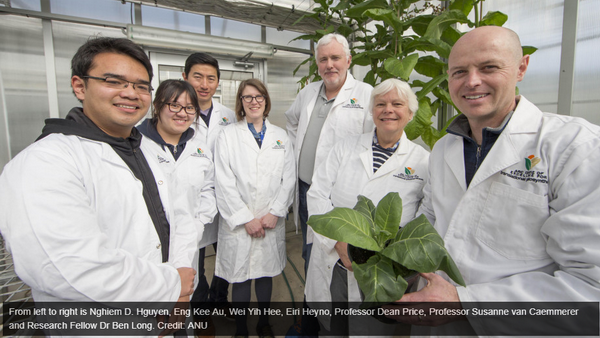
Blue-green Algae Promises to Boost Yields of Important Food Crops
September 12, 2018| |
Scientists at the Australian National University (ANU) have engineered tiny carbon-capturing engines from blue-green algae into plants. This breakthrough promises to help boost the yields of important food crops such as wheat, cowpeas, and cassava.
Lead researcher Dr. Ben Long said that for the first time, they have inserted tiny compartments from blue-green algae, also known as cyanobacteria, into crop plants that form part of a system that could lead to a 60 percent increase in plant growth and yield. The compartments, called carboxysomes, make cyanobacteria so efficient at transforming carbon dioxide into energy-rich sugars. Dr. Long's team is trying to insert a turbo-charged carbon-capturing engine into plants by mimicking cyanobacteria.
Rubisco, the enzyme that fixes carbon dioxide from the atmosphere, is slow and finds it difficult to differentiate between carbon dioxide and oxygen, leading to wasteful energy loss. Cyanobacteria, however, uses a 'CO2 concentrating mechanism' to deliver large amounts of the gas into their carboxysomes, increasing the speed of CO2 transformation into sugar and minimizes oxygen reactions. The Rubisco enzyme inside cyanobacteria captures carbon dioxide and generates sugars about three times faster than the Rubisco found in plants.

For more details, read the ANU news release.
| |
Biotech Updates is a weekly newsletter of ISAAA, a not-for-profit organization. It is distributed for free to over 22,000 subscribers worldwide to inform them about the key developments in biosciences, especially in biotechnology. Your support will help us in our mission to feed the world with knowledge. You can help by donating as little as $10.
-
See more articles:
-
News from Around the World
- IITA Wins 2018 Africa Food Prize
- Researchers Discover Hormone Helps Plants Build Ventilation System in Leaves
- Pipecolic Acid Found to Initiate Plant Disease Resistance Pathway
- Argentina to Release Drought and Salt Tolerant Soybean
- Australian OGTR Approves Field Trial of GM Canola
- Policy Makers and Lawyers Participate in Biotech Fora
- Blue-green Algae Promises to Boost Yields of Important Food Crops
- New Alliance to Promote Vision of a Pan-Continental European Research Area
- COGEM Concludes Negligible Environmental Risk of GM Soybean
-
Research Highlights
- RNAi Used to Confer Verticillium Wilt Resistance in Cotton
- Salt Tolerant Rice Lines Developed for Mekong Delta
- Vietnamese Researchers Report Heat Tolerant Plant Transformation
- Scientists Find the Genetic Basis of Brown Fiber Cotton
-
Beyond Crop Biotech
- CRISPR-Cas9 Helps Find New Antidepressant Drugs
- GE Mosquitoes to be Released in Africa for the First Time
-
Plant
- Male Sterile Lines in Maize Developed Using CRISPR-Cas9
- Efficient, Precise Multiplex Genome Editing Developed in Tomato
- Scientists Use CRISPR-Cas9 to Accelerate Breeding for Modified Starch in Cassava
-
Read the latest: - Biotech Updates (December 17, 2025)
- Gene Editing Supplement (December 17, 2025)
- Gene Drive Supplement (February 22, 2023)
-
Subscribe to BU: - Share
- Tweet
